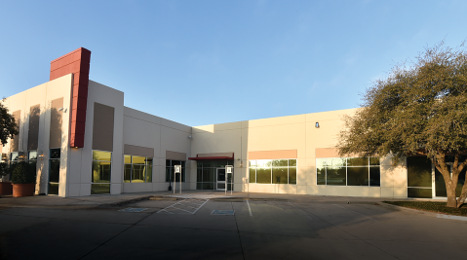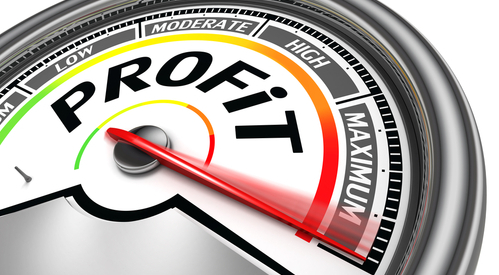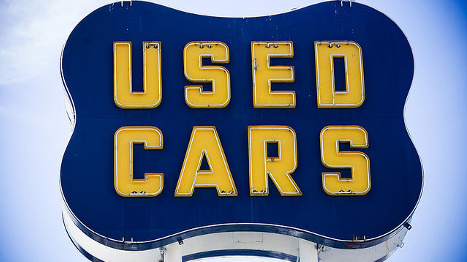Lithia Motors president and chief executive officer Bryan DeBoer isn’t backing down from his objective that each of the group’s 130 dealerships in 14 states turn at least 75 used vehicles each month. In fact, DeBoer pointed to a pair of reasons as to why the company can see a lift from the average of 57 used retail sales the group generated during the first quarter of this year.
During Lithia’s quarterly conference call, DeBoer noted how the wholesale supply of what Lithia calls its “core used-car product” is starting to “loosen,” in part because of the new-vehicle SAAR staying near at or above 16 million “for some number of years.”
With that situation in mind, Lithia dealerships being able to find vehicles that are 3- to 5-years-old, the group’s “core product,” DeBoer said, “We really believe that that’s a pretty easily accomplished task.”
And consequently, the vehicles that often come in via trade when Lithia moves a core unit can fill the lots of what Lithia calls its value auto department. These units typically have more than 80,000 miles and often are sold to consumers with subprime credit histories.
DeBoer mentioned the 27 DCH stores that came into the Lithia pipeline last year typically didn’t pull the value auto lever within the used-vehicle department.
“It is a slow process, and it was with Lithia,” DeBoer said. “No matter what they have, there is lots of opportunity with their top of funnel trade-ins. That’s probably the easiest way to get to those value auto cars.
“We’re really excited to see the early stages as some of the stores start to take hold in that value auto segment,” he continued. “And I know general managers and service management teams are working closely to be able to recondition those cars and then market those cars to consumers that may not have looked toward the DCH stores in the path for that type of vehicle.”
DeBoer went on to emphasize to investment analysts who inquired about Lithia’s used-vehicle objectives that the group is trying to think well beyond this year.
“We continue to focus on procuring core product and selling 75 used units per store per month. We believe that the increased availability of used cars presents a continued opportunity for our stores to increase unit sales in the future. This remains a top priority for our teams in 2015 and beyond,” he said.
“So as we look at the year going forward and we look at the supply sort of there, I think it really comes down to a belief that they can start to find these vehicles and buy those core products that take in those value vehicles,” DeBoer continued later in the call.
Reaction to FCA Pricing Moves
Switching to the new-model side of the business, analysts wanted to know Lithia’s reaction to the pricing modifications Fiat-Chrysler made recently. Currently, 18 percent of the group’s dealerships are FCA stores, selling Fiat, Chrysler, Dodge, Ram and Jeep vehicles.
Lithia executive chairman Sid DeBoer tackled that question since he’s a member of the FCA National Dealer Council.
“Obviously, we’re not excited about them changing what appears to be our margin. But in reality, it could work out in our favor,” he said. “They’ve brought themselves in line with where Ford and General Motors are in terms of a discount, in terms of MSRP. But in reality, they’ve got such a stair-stacked incentive program, if nothing else, it’s put more money available because they are not going to give up market share.”
DeBoer then cheered the new-vehicle sales momentum FCA has enjoyed for quite some time.
“They are on a roll. They’ve gained market share. I think for, what, 16 months in a row. I just don’t see them allowing that to impact sales at all,” he said. “So it could end up, there is more of the gross profit hidden from the customer then. If they put it back in the incentive drawer, it could help margins.
“So I’m not negative on it. I don’t like it. I think it’s nice to have a high price and some room to trade but that’s just the old fashioned car dealer in me,” DeBoer went on to say.
More Acquisitions?
Lithia didn’t offer any specific store names, but Bryan DeBoer divulged the group has identified more than 2,600 potential targeted dealership acquisitions.
The most recent move Lithia made wasn’t an acquisition; rather the group opened Subaru of Clearlake in Texas. The store is a new franchise the group was awarded from Subaru with which Lithia estimated will contribute approximately $45 million in annual revenues.
“The acquisition market is robust and we anticipate continued activity as independent dealers seek attractive exit strategies,” Bryan DeBoer said. “We remain focused on pursuing accretive acquisitions and will continue to add locations to our portfolio in the future.
“We are not solely looking at $500 million or $1 billion acquisitions,” he continued. “We’re still looking at our typical strategies where we buy $50 million to $70 million store size. And there is a pretty active market in that arena both in our exclusive markets and now in the metropolitan markets.”
One figure appeared four different times when Lithia Motors reported the highest first-quarter adjusted net income in company history on Wednesday. Lithia enjoyed 11-percent increases in four major performance categories, including:
— Used-vehicle retail same-store sales
— New-vehicle same-store sales
—Total same-store sales
—Service, body and parts same-store sales
The Q1 performance of those four dealer business areas helped to propel Lithia to an increase in adjusted net income from continuing operations of 36 percent compared to the prior-year period. That adjusted net income from continuing operations figure came in at $36.9 million, or $1.39 per diluted share, up from $27.1 million, or $1.03 per diluted share, a year earlier.
The company’s first-quarter revenue soared $711 million (or 66-percent) higher to $1.8 billion, up from $1.1 billion in the same period last year.
Now with DCH Auto stores in the Lithia portfolio, the dealer group’s sales figures are significantly higher year-over-year. Here are some of the highlights in connection with the used and F&I departments and year-over-year comparisons:
— Used retail unit sales: 24,204, up by 7,888 vehicles (or 48.3 percent)
— Average used-vehicle selling price: $19,126, up $623 (or 3.4 percent)
— Average gross profit per used-vehicle retail sale: $2,456, down $44 (or 1.8 percent)
— Finance and insurance gross profit per retail sale: $1,178, down $2 (or 0.2 percent)
On a same-store basis, Lithia pointed out that F&I per unit increased $52 to $1,233. The company added that adjusted SG&A expense as a percentage of gross profit came in at 71.3 percent
"We delivered the best first quarter earnings in our company’s history, and the second best quarterly earnings ever,” Lithia president and chief executive officer Bryan DeBoer said.
“For the fourth consecutive quarter, we achieved double-digit growth in same-store sales in all business lines,” DeBoer continued. “On a continuing operations basis, we grew revenue 66 percent and adjusted net income 36 percent over the first quarter of 2014.
“We remain focused on capturing additional market share, improving existing store results, the continued success, integration and growth of DCH and actively seeking accretive acquisitions,” he went on to say.
Senior vice president and chief financial officer Chris Holzshu noted SG&A as a percentage of gross profit ended up slightly higher than the prior year due to the effect of Lithia’s DCH acquisition and better than the company’s projection.
“We target improving SG&A as a percentage of gross profit as we integrate the 36 stores added in 2014,” Holzshu said.
“In the first quarter, incremental throughput, or the percentage of additional same store gross profit dollars that we retain after deducting incremental selling costs, was 45.1 percent,” he continued.
“Our stores remain focused on maintaining incremental throughput of 45 percent to 50 percent, which will continue to lever our SG&A expense going forward,” Holzshu added.
Editor’s Note: For Lithia’s perspective on how increased wholesale supply is going to enhance its used-vehicle performance during the next year and beyond, be sure to watch for Monday’s edition of Auto Remarketing Today.
Asbury Automotive Group’s management expects the retailer’s Q auto program to show run rate profitability by the end of the year and said the standalone used-car outlet program is actually ahead of schedule on the financial side.
In his early remarks during Tuesday’s first quarter earnings conference call, Asbury senior vice president and chief financial officer Keith Style said the Q auto program “continues to progress in line with our expectations.”
It resulted in an earnings per share loss of $0.03 during Q1, which is better than the prior estimated loss of $0.04 to $0.06, Style said.
“Looking to near-term expectations, we estimate this initiative may reduce EPS by 1 to 3 cents in the second quarter of 2015,” Style continued. “We continue to focus on our objective of achieving run-rate profitability for Q auto by the end of the year.”
Then during the Q&A portion of the call, when an analyst asked management to gauge Q auto’s performance against its expectations, president and chief executive officer Craig Monaghan said the Asbury is “happy with the progress” made by the used-car program
“I’d say we’re actually maybe moving slightly ahead of where we expected to be, as you saw in the results of this quarter; we had a 3-cent loss, we’re anticipating a loss of 1 to 3 cents next quarter, so we think we’ll continue to make progress,” Monaghan said.
What Format of Q Auto Works?
The Asbury CEO was asked by the same analyst to provide some additional color on the Q auto format (which consists of small, medium and large stores) and on when Asbury could make a final decision on what ultimately happens with Q auto.
“I think we’re learning that the smaller formats are most effective. The larger format is more challenging, but we think there’s still opportunity in that store,” Monaghan said. “The other thing we’re learning is that the stores that are opened the longest are the stores that are doing the best. I think that’s something that you might expect.
“With respect to where do we go from here, I think we continue to look at this as a tremendous opportunity for us to utilize today’s technologies and some of our in-house expertise, and figure out if we can’t retail some portion of the 35,000 cars that we’re sending to auction every year,” he added.
“And I think we’re making progress in that direction. Our objective is to achieve run-rate profitability by the end of the year,” Monaghan said. “We think we’re heading in that direction, and I think at this point, we just ask for some patience while we continue to work on it, and see where we can get (to).”
‘Just Right the Way We’re Doing It’
It’s a “puzzle” Asbury is trying to solve, Monaghan says, this process of building a marketplace to retail at least some of the tens of thousands of vehicles it would normally wholesale.
Asbury has “a lot to learn,” he said during the Q&A, and you can expect more technology to arrive in Q auto stores as the company continues to work with its partners.
“We’re working with our technology partners, we’re working with our financing partners, we’re experimenting with a number of different things. We think it’s just right the way we’re doing it, and this is what we want to stay focused on right now,” Monaghan said.
Another thing Asbury is looking to determine is who, exactly, Q auto customers might be, Monaghan said later during the Q&A. What the company has found so far is that the customers vary by market.
“In one of the markets, for example, it’s primarily subprime,” he said, “but in another market we can sell luxury cars.”
Monaghan, who was answering a question from an analyst about the rationale behind the investment in establishing a separate brand and standalone stores, would then go back to what he called the “overriding view” on Q auto.
“We’re not consuming a lot of capital with this. It is not terribly disruptive to our core operations. We’ve carved out a group of people who are dedicated to it. And we’re learning. And I think that’s the important thing; we’re learning,” Monaghan said.
“I think brand is important; obviously, a brand is important. And we do believe that as we these stores continue to operate and get more time under their belt, they are becoming more relevant in their marketplace, they’re becoming more relevant online and we think those are some of the things that are helping them continue to improve their volumes,” he said.
“And we’ve just got to continue down that path,” he added. “It’s going to take some time. But we feel like we’re headed in the right direction and it is well worth our effort, and your investor and our investment to shareholders, to give this thing a shot. In fact, we think we’d be remiss if we didn’t give it a shot because there’s a real opportunity here.”
Sonic Automotive hosted its quarterly conference call Tuesday morning for the first quarter of 2015, outlining a company record first quarter from the angle of several metrics, including record first quarter pre-owned units sold (28,135) from continuing operations as well as a record first quarter pre-owned gross profit of $40.8 million.
The first quarter of 2015 also marked the first complete quarter of operations for the company’s Denver-area EchoPark stores, which retailed 660 units in Q1. Nearly 300 of those units were sold in March following what the company’s executive vice president of operations Jeff Dyke described as less than favorable weather experienced in the area.
The company plans to open its fourth Denver-area neighborhood store in Dakota Ridge in the fourth quarter of this year to continue its wheel-and-spoke strategy of opening its EchoPark stores in the Denver market area. Dyke also mentioned that it will have two more Denver-area locations opening in the second quarter of 2016.
The second market for EchoPark, which is currently being referred to as EchoPark 2, will hopefully be open by late summer 2016, according to Dyke, but the location of the market has not yet been announced.
When asked what Sonic’s level of commitment is to EchoPark and how invested the company is in its success, Dyke responded: “We’re not experimenting.”
“We don’t feel like we had any barriers of entry into this,” Dyke continued. “We feel like there’s one major player with 45 million pre-owned cars being sold a year and this is something that we’ve been working on for the last seven years. Like (Sonic president) Scott Smith said earlier, this is no experiment.
“We’ve got our second market picked out. We even have our third market picked out,” Dyke said. “We’re in, we’re rolling forward, and we’re meeting and or beating our expectations. Something drastic would have to happen for us to pull back on that.”
Warren Buffett now is officially a dealer, and according to the famous investor whose net worth tops $70 billion, “the fun has just started.”
Buffett’s famed company, Berkshire Hathaway, on Tuesday completed its acquisition of the Van Tuyl Group, the largest privately held dealership group in the United States. The company claimed this historic transaction, which first was announced in October, is the largest in the retail automotive industry's history.
The company has been renamed Berkshire Hathaway Automotive and is headquartered in Dallas.
Larry Van Tuyl will serve as chairman of the board of the new company. Jeffrey Rachor, formerly Van Tuyl Group's president, will be chief executive officer of the enterprise.
Buffett explained the cornerstone of the Van Tuyl business model is local entrepreneurial dealership managers with minority ownership stakes. He indicated every managing partner has enthusiastically committed to stay on with Berkshire Hathaway Automotive, and they will remain equity partners in their respective dealerships.
“This is the beginning of a journey that will have no end,” Buffett said. “Cecil and Larry have given us the ideal platform with which to build an auto dealership business that will be thriving and growing 50 and 100 years from now.”
Larry Van Tuyl shared some details about how this transaction unfolded.
“Mr. Buffett and I made this deal on a handshake and it is no surprise that completing the transaction went smoothly and according to plan,” Van Tuyl said. “Berkshire Hathaway’s acquisition of the Van Tuyl Group has been embraced by all internal and external stakeholders.
“I want to take this opportunity to thank our manufacturer partners for their universal support and approval of the transfer of their franchises,” he continued. “Warren Buffett and Berkshire Hathaway are the perfect owners of this business. My father Cecil, the original founder of the Van Tuyl Group, would be very proud today."
Now as Berkshire Hathaway Automotive CEO, Rachor added, "Our partners and 10,000 plus associates are extremely proud and excited about the bright future as Berkshire Hathaway Automotive. We are all grateful that Mr. Van Tuyl found the ideal buyer to preserve the Van Tuyl business model and our unique entrepreneurial culture.
“The organization will continue to execute our simple strategy of operational excellence and sensible growth through acquisitions,” Rachor went on to say.
Penske is coming off of a record breaking year, success which in part is due to its recent acquisitions.
For retail automotive, specifically, the company acquired $225 million in annualized revenues last year, including the purchase of BMW of Greenwich, Conn., with revenue of $200 million annually.
And so far in 2015, the company has already bought a Land Rover dealership in Darien, Conn., with estimated annualized revenues of approximately $50 million.
As the company ramps up acquisitions even more this year, market analysts posed a series of questions to company chairman and chief executive officer Roger S. Penske regrding whether commercial or light vehicle acquisitions would take a front seat in 2015.
During the company’s conference call to discuss full-year and quarterly results, Penske said in 2015, 50 percent of acquisitions will be on the commercial side of the business while the other 50 percent will be divided equally between the U.S. and the international light-vehicle market.
Penske has already begun to show a focus on the commercial side of the business, as it also announced this week it has renamed its U.S.-based commercial vehicle dealership business to Penske Commercial Vehicles, US, which formed Daimler exec Richard Shearing will be heading up.
During the call, Penske explained commercial acquisitions are often less complicated than light vehicle stores.
"To the point of commercial vehicles, what we see is lower valuations from the standpoint of commercial vehicle and acquisitions. There is no question it is 25 to 30 percent less from a goodwill percepective versus premium luxury automotive," he said.
"From the standpoint of future (capital expenditures), there is significantly less requirements from the commercial vehicle aspect that there are in some of the showrooms and things we have to deliver to the OEMs," Penske continued.
The exec also noted rent discrepancies play a large role in the company’s acquisition decisions.
“Quite honestly, the rent factors are significantly lower in these cases (commercial) where we’ve purchased these businesses and then releasing back from the operators,” Penske said.
An expanded commercial vehicle focus is also tied to increasing gross profit.
“I think another key metric there is when you look at the gross profit on the auto side if you look, our results were probably around 9 percent to 10 percent sales revenue, and parts and services with a 40-percent gross profit.
If you look at the commercial vehicle business, that gross profit is approaching 70 percent for the company.
Penske pointed out the company’s background in commercial vehicles is driven from moves made back in 1988, when it acquired Detroit Diesel from General Motors and ran that business for 13 years. Since many of the customers in the U.S. and even internationally used the company’s engines, Penske pointed out “we have a great knowledge of the customer base and relationships.”
More recent growth in the commercial side of the business stemmed from Freightliner Trucks' consolidation.
“When Freightliner decided that they wanted to consolidate their dealership group and they have 40 percent of the market, we jumped on-board there and made a couple of strategic acquisitions, and we see that is a great vertical for us as we go forward to balance our domestic and our international in with our commercial vehicle, and certainly in our knowledge of the truck business because of our big fleet makes it a positive for us as we go forward,” Penske said.
“I think overall we're going to see more pull through from the commercial vehicle side,” he noted later in the call.
And with the dealership acquisition environment being hot right now, on the commercial and light-vehicle sides of the business, Wall Street analysts also asked Penske if he would be willing to let go of any current stores or relocate capital to other locations.
“I think we're looking at that in all of our businesses and obviously things that maybe looked quite beneficial to us several years ago we might have changed our mind in certain markets. So, we'd be adding and subtracting those businesses as we go forward, but I think that we're going to stay focused on foreign name plates, volume foreign and primarily in the premium luxury (market),” Penske said.
“So I would say that the focus would be premium luxury volume foreign. Obviously, there might be some opportunities on the domestic side,” Penske added.
The chairman and CEO was also asked why the company continues to have a strong preference for import brands, rather than turning to the Big 3.
“Yes, I would say since our mix for the last 15 years has been driven towards premium/luxury and volume foreign. We missed the boat you might say on some of the larger, better acquisitions on the domestic side; we have some good GM business, some Ford business and some Chrysler business, but it is much, much smaller than the other peers on the public side. But we're talking to Chrysler, GM and Ford about opportunities, but we got to get one to have the right scale and for sure have to be in markets where we already have a footprint,” Penske concluded.
When asked if Cadillac was on the company’s radar at all for future light-vehicle store acquisitions, Penske said if the company could get Cadillac in the “right market,” they would certainly be interested because it’s a premium/luxury brand, a branch of the market the dealer group specializes in.
The fourth quarter of 2014 wrapped up what was Penske Automotive Group’s most profitable year ever.
The company announced Wednesday, revenue in 2014 increased by 18.9 percent to a total of $17.2 billion, $4.4 billion of which was made in Q4. And in 2014, Penske retailed a grand total of 398,356 new and used vehicles.
And its automotive retail sales in the fourth quarter played a large role in the company’s success, including a 10.5 percent increase in total retail unit sales and a 6.8 percent jump on a same-store basis.
Total retail sales came in at 98,251 for the quarter, and sales, in the U.S. specifically, were up 8 percent.
The company’s used sales during Q4 were up 9.2 percent, coming in at 44,083 total sales for the quarter. The company’s annual used sales for 2014 were up to 181,894, spiking 11.4 percent from 2013 rates.
New sales were up by double digits, as well. Penske sold a total of 216,462 new vehicles in 2014, up 10.7 percent from 2013.
Dealers were also making a bit more on these new and used units as 2014 wrapped up. The average transaction price of a used vehicle at a Penske dealership came in at $27,035 in Q4, marking a 1.5 percent increase.
The average new-car sales price as 2014 closed out for the company was $40,642, up 0.8 percent.
With this increase in sales came a spike in retail revenue, as well, Penske reported.
There was a 8 percent spike in same-store used retail revenue during Q4, while the F&I office played a role, as well, with dealers making 10.1 percent more in this branch of the business.
And with the influx of recalls in 2014, service and parts same-store retail revenue was up 6.2 percent during Q4.
"Our retail automotive dealership business produced another strong quarter across both the U.S. and the U.K.," said Penske Automotive Group chairman Roger S. Penske. "Same-store retail revenue increased 8.3 percent, and we had a 90-basis-point increase in our service and parts gross margin to 59.7 percent, which helped drive another record quarter for our business. Strong results across the retail automotive dealership business and our U.S.-based commercial vehicle dealership business were partially offset by our Australian operations which were impacted by challenging economic conditions and post-acquisition restructuring costs within the Power Systems business."
Part of the company’s success in 2014 was also due to its acquisitions. For retail automotive, specifically, the company acquired $225 million in annualized revenues last year, including the purchase of BMW of Greenwich, Conn., which revenue of $200 million annually.
And so far in 2015, the company has already bought a Land Rover dealership in Darien, Conn., with estimated annualized revenues of approximately $50 million.
Looking back at 2014, Penske announced it was a record-breaking year for Penske Automotive.
"We completed the most profitable year in the history of our company, generated another year of strong cash flow and solidified our balance sheet. The retail automotive and commercial truck markets remain robust and we remain optimistic about the future growth and profitability opportunities for our company,” he concluded.
Editor’s Note: Stay tuned to Friday’s Week In Review for a more in-depth look at Penske’s Q4 and full-year 2014 results.
The top executive at Group 1 Automotive doesn’t foresee a “dramatic” fall-off in used-car prices, and while there are certainly downward pressures on values, Earl Hesterberg pointed out a few mitigating factors at play when he addressed questions during the company’s quarterly conference call.
In the Q&A portion of Thursday’s call, an analyst brought up the widespread concerns about a potential drop in used-car prices that seem to be at odds with the transaction price strength that Group 1 and its peers have enjoyed.
In addressing the analyst’s question, Hesterberg — Group 1’s president and chief executive officer — acknowledged pressures that are negatively impacting used values, but also explained other dynamics at work.
“I think the relative price level probably will continue to be under a little bit of pressure, but as you may have noticed, our CPO business grew a lot,” Hesterberg said.
“And I think because there’s an increasing supply of off-lease vehicles, particularly for the luxury brands, that’s driving up some of the average transaction prices and that will probably continue,” he continued. “But there will also continue to be increasing off-lease supply, which may put a little negative pressure.
“So, maybe the mix is richening up a bit, but I think the supply and the aggressive marketing of new vehicles is going to continue to put a little downward pricing pressure on used-vehicle prices overall,” Hesterberg said.
The analyst then followed up with a question to gauge how problematic this trend may be when it comes to trade-in values and consumers not having as much value in their cars. Again, Hesterberg does not see this being a huge problem, at least in the short term.
“I don’t think it’s going to be a big deal in the near term. I think that only becomes a big deal if it’s something dramatic,” he noted. “And I don’t see anything dramatic happening.”
NADA Used Car Guide addressed some of these very concerns in its latest Perspective report.
While listing several factors likely to drive strength in used prices — including economic gains, declining unemployment, gains in home prices and significantly lower fuel costs — NADA said it believes these positive impacts won’t be able to match the downward pressures. Credit conditions won’t be quite as rosy, and the impact of that plus new-market pricing pressures and what NADA called the most important factor (increased used supply) will dampen used prices.
How much? NADA pinpoints the year-over-year decrease for vehicles up to 8 years old somewhere between 2 percent and 2.5 percent this year.
“Looking further ahead, used price movement will be determined by a variety of factors, some of which will be harder to predict than others. Automaker production and incentive actions are just two factoring examples,” NADA’s report explains.
“However, we can pinpoint used supply growth with far greater accuracy and can state with confidence that the additional volume will pressure down prices even more in the coming years,” it adds. “Recognizing this, lenders, automakers and others with longer-term investments in used vehicles can better prepare for the challenges that lie ahead.”
Offering a different take, Jeffrey Brown, the new CEO of Ally Financial, also addressed used-car prices during his company’s most recent quarterly call.
“Used-car prices have continued to soften. I think that is more a supply dynamic than anything else. Again that’s created some volatility in some of our margin line items where lease gains run through,” he said. “We would expect used-car prices to keep coming down in the neighborhood of about another 5 percent this year.”
Editor's Note: Staff Writer Nick Zulovich contributed to this report.
Group 1 Automotive retailed nearly 94,000 used vehicles in the U.S. last year, beating 2013 figures by close to 10 percent.
And while per unit figures and gross margin percentages on the used retail side were down, the company increased its used retail gross profits by more than 5 percent.
Reporting fourth quarter and full-year 2014 results Thursday, Group 1 had 93,813 retail used-vehicle sales in the U.S. last year, compared to 85,365 in 2013.
Gross margin percentage on used retail sales for the year was 7.8 percent, down from 8.2 percent.
Group 1 pulled in $149.94 million in gross profits in its domestic used retail operation, which was up 5.6 percent year-over-year. Gross profit per used retail unit sold was $1,598, down from $1,664 in 2013.
Looking at Q4 used results for the U.S., Group 1 sold 23,446 used retail units for a 16.6-percent year-over-year increase.
Gross margin percentage on these was 7.3 percent, up from 7.2 percent in the same quarter of 2013.
Gross profits on used retail sales was $35.33 million, compared to $30.16 million a year earlier. Per unit, gross profit on used retail sales was $1,507 in Q4, up 0.5 percent year-over-year.
Sharing some commentary on the entire spectrum of the company’s overall results (including U.S. and international operations), Group 1 president and chief executive officer Earl Hesterberg said in the earnings release: “We are delighted to announce all-time record adjusted earnings for this quarter and the full year. For the quarter, the results reflect double-digit revenue growth, improved margins, and impressive cost control.
“Each of our geographic markets delivered significant improvements, with continued strong growth in the U.S. and U.K. and the benefits of cost reductions in Brazil driving higher earnings in all three countries,” Hesterberg added. “For the full year, revenue increased more than $1 billion, which in combination with improvements in our cost and capital structure, translated into record adjusted full year earnings of $5.87.”
The used-car background runs deep at Sonic Automotive. Founder and chief executive officer Bruton Smith got his start in used cars, and has passed that tradition on to his children, as well.
And the used-car business was also the starting point for Sonic’s executive vice president of operations, Jeff Dyke, who talked about this with Auto Remarketing in a November interview, explaining the importance of the pre-owned market for the dealership group.
“It’s really the core of our business. And we believe that if you know what you can retail a used car for, you can put more money in that car, you’ll trade for more cars, and ultimately, it’s going to grow your market share on the new-car side,” he said.
“Sort of the center of our universe is the pre-owned business,” Dyke added. “And we think we do that very well. Also, Sonic was the staging platform for us to do a lot of testing with technologies and processes and training in order to bring EchoPark to life.”
EchoPark Automotive, of course, is the pre-owned vehicle retail store concept recently launched by Sonic in the Denver area that Dyke called “kind of a cross between Apple (store) and a Google experience.”
Efforts like EchoPark are among several moves Sonic has made to push used-car operations. That includes remarketing teamwork with Manheim, both on a large and small scale, as well as continued progress in its Sonic Inventory Management System.
Dyke explained that Sonic has focused on moving the wholesaling of vehicles from an individual-store basis to a more centralized approach from the corporate office, which Dyke says leads to greater efficiency.
“We’re trying to centralize everything having to do with inventory management,” he said, “and getting our stores focused on the guests.”
“So one of the other things we’re doing is, we’re taking the wholesaling of cars out of the store’s hand. And we’ve got a retail trade center at our corporate office where we’re wholesaling cars through video across the Manheim lanes.”
Going back to the retail side, Sonic has made the certified pre-owned business a strong focus. But it’s also important to maintain a balance in terms of CPO versus non-CPO, Dyke says.
“It’s obviously a big part of our business,” he said of CPO. “It’s a third of our (used-car) business. We believe that if it becomes more than a third of our business, we’re missing out on more used-car volume in other areas, but it shouldn’t be any less than a third of our business.”
Editor's Note: This story is featured in the January issue of Auto Remarketing, as part of our on-site coverage of the NADA Convention & Expo.












